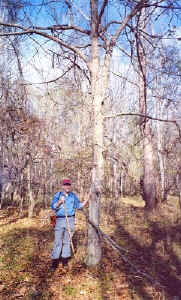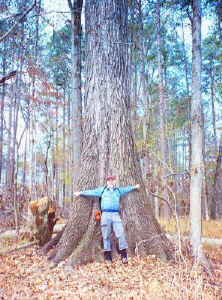| Rock
Creek, Oconee NF, GA |
Jess
Riddle |
| Dec
12, 2005 09:31 PST |
Ents,
Around Thanksgiving, my dad and I visited Rock Creek in
Georgia's
Oconee National Forest. A friend who remembered seeing large
hardwoods in the area while conducting salamander surveys tipped
us of
to the area. Surrounded by rolling hills in the central part of
Georgia's piedmont, the watershed drains from 650' elevation to
350'
over the course of approximately seven miles. The abundance of
easily
accessible loblolly pine in the watershed and elsewhere in the
NF has
allowed the Oconee NF to be profitable. However, the uplands do
not
feature good soils; an approximately 18" dbh white oak that
fell
across one road in the area was 66 years old, and blackjack oak
competes successfully on surrounding ridges. If left
undisturbed, the
loblolly pines would likely eventually give way a white oak
forest
with some post oak, southern red oak, and mockernut hickory.

A 15'3" cbh and 127.8' tall willow oak growing in the floodplain. |
Contrastingly, hardwoods already dominate the relatively fertile
bottomlands. Only the lowest mile of the creek has a well
developed
floodplain, but much of that length appears little disturbed in
the
past hundred years. The narrower floodplain on the upper half of
that
stretch, perhaps 150 yards across, and the much broader lower
floodplain have disparate tree assemblages. Tuliptree, sweetgum,
sycamore, and cherrybark oak dominate the upper portion of the
floodplain, with spicebush occurring in the one part of the
understory. Green ash with cottowood, red maple, boxelder,
sweetgum,
and sugarberry mixed in forms the lower section's canopy.
Pockets of
loblolly pine grow throughout, and river cane forms locally
dense
understories. Paw paw is conspicuously absent from the
understory.
Species Cbh Height
Ash, Green 7'2" 123.0'
Ash, Green 7'6" 126.1'
Blackhaw, Rusty 2'0" 29.4'
Boxelder 4'11" 78.3'
Boxelder 5'3" 81.9'
Cottonwood 10'4" 121.1'
Cottonwood 10'1" 133.2'
Cottonwood 10'9" 133.4'
Cottonwood 12'3" 134.9'
Elm, Winged 4'9" 109.0'
Hawthorn, Green 2'6" 42.0'
Mulberry, Red 3'6" 66.1'
Mulberry, Red 4'5" 75.6'
Oak, Cherrybark 13'5' 147.3'
Oak, Cherrybark 15'8' 149.9'
Oak, Shumard 16'8" 131.1'
Oak, Southern Red 8'0" 105.5'
Oak, Water 10'0" 119.5'
Oak, Willow 15'3" 127.8'
Pine, Loblolly 7'10" 130.5'
Spicebush 1'0" NA
Sugarberry 5'0.5" 108.6'
Sugarberry 6'4" 110.1'
Sugarberry 6'8" 117.8'
Sycamore 9'9" 122.8'
Sycamore 11'11" 129.9'
Tuliptree 13'7" 116.5'
Tuliptree 10'3" 131.2'
The rusty blackhaw is by far the largest I have seen, and is a
potential state champion. The tree has one branch that comes off
below 4.5', so a fairer circumference would be 2'4". The
boxelder
represents a state height record, but very few individuals of
the
species have been measured in the state. The same applies to
winged
elm.

A potential state champion green hawthorn growing in the Rock Creek floodplain. The tree is 2'6" cbh, 42.0' tall and has a maximum branch spread of 36.5'. |
The green hawthorn is also a potential state champion of an
undermeasured species. The red mulberry edges out a tree in the
Smokies as a new eastern height record. The cherrybark oaks are
the
tallest known in the state, but again the bottomlands have not
been
thoroughly searched.

A potential state champion shumard oak growing at the edge of the floodplain. The tree is 16'8" cbh, 131.1' tall, and has a maximum spread of 92'. |
The shumard oak has substantial root flair
and
will easily out-point the current state champion. In addition to
the
oaks with measurements listed above, blackjack oak, post oak,
white
oak, northern red oak, chiquapin oak, and swamp chestnut oak
were also
present for a total of 11 species from the genus. Taller
loblolly
pines are almost certainly present. The sugarberry is an eastern
height record for a species ENTS has few measurements of.
Sweetgum
reaches at least 120' at the site, but was not measured. Taller
tuliptrees were certainly present, and circumferences around 10'
were
common.
Rucker Index 129.9'
Cherrybark Oak 149.9'
Cottonwood 134.9'
Tuliptree 131.2'
Shumard Oak 131.1'
Loblolly Pine 130.5'
Sycamore 129.9'
Willow Oak 127.8'
Green Ash 126.1'
Water Oak 119.5'
Sugarberry 117.8'
Jess Riddle
|
| RE:
Rock Creek, Oconee NF, GA |
Robert
Leverett |
| Dec
12, 2005 11:26 PST |
Jess,
Wow! It is fascinating to sit back and watch as new spots emerge
out
of the fog. Some of the new sites are changing our perception of
what is
left in tall and large trees in different regions of the
country. I had
written off central Georgia as likely not going to produce
anything of
significance and kaboom. The picture changes.
I like to periodically cycle back and review
where we are. What do
you, Will, and others think of the following observations?
1. It appears from the data that we've
collected that the cherrybark
oak is the king of oaks as far as height is concerned
2.Live oaks are the biggest in the oak family
as far as volume is
concerned.
3. In terms of what grows today, the white
pine continues to lead the
pack as the tallest of the pines (indeed the tallest eastern
species).
4. The loblolly seems to be winning as the
bulkiest of the pines.
5. The lordly tuliptree continues its
unchallenged reign as the
tallest eastern hardwood. In terms of sheer numbers of tall
hardwoods,
it seems to be pulling farther and farther away from the pack.
6. The American sycamore is duking it out with
the live oak for the
largest hardwood in volume. I realize that the Middleton oak is
the
single largest eastern tree in terms of volume, but I don't know
where
the species stands as a whole relative to the sycamore.
Historically,
there were larger sycamores than the Middleton oak. Old photos
confirm
that.
7. In terms of overall largest eastern species
in volume, we have the
American sycamore, live oak, baldcypress, and probably the
tuliptree can
still be included in the running. Historically, we would have
had to
include the American chestnut, but not any more.
So, in terms of height, where do we stand with
various species of the
hickories? The jury is definitely out here in southern New
England and
across New York. Pignut, bitternut, and shagbark are in a tight
race.
Bob
|
| RE:
Rock Creek, Oconee NF, GA |
Robert
Leverett |
| Dec
12, 2005 13:44 PST |
Jess, Will, Will, et al:
It is personally satisfying for me to see big
tree numbers emerging
from Georgia. While North and South Carolina are still the clear
winners
in the tall tree contests, I just can't fathom why a state as
large as
Georgia wouldn't have plenty of hot spots with at least clumps
and
narrow bands of truly impressive trees. I'm sure the same must
be true
for Alabama and Mississippi and perhaps Arkansas. It has already
proven
to be true for Tennessee west of the Smokies.
I believe that the original forest of the deep
South that was cleared
to plant tobacco, peanuts, and cotton was something to behold.
Then
there is Kentucky. It has to have some closely guarded secrets.
If we
can attract a few dedicated tree measurers located in the deep
South,
the picture of what that land can still grow might take a huge
leap
skyward. My last trip across Mississippi, which was back in the
1980s, I
recall many roads lined with young, but very tall sweetgums.
Tall
sweetgums were common as weeds. I remember commenting to my wife
Jani at
the time. I also remember a residential neighborhood we drove
through in
Memphis. I was astounded at the abundance of stately oaks. I
presume
they were cherrybark, shumard, and laurel oaks. I've never
encountered
such trees as I saw in a New England town.
Bob
|
|